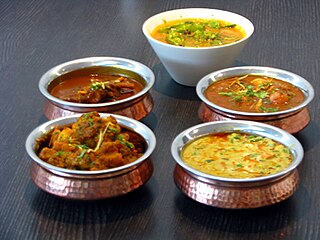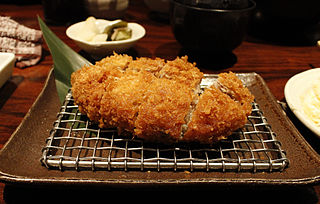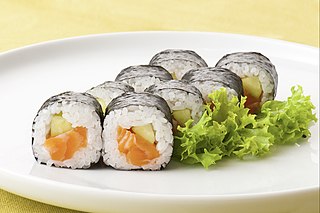

Tenmusu, also spelled as ten-musu, [1] is a dish in Japanese cuisine that consists of a rice ball wrapped with nori that is filled with deep-fried tempura shrimp. [2] [3] Tenmusu is sometimes included as a food in bento boxes. [1]


Tenmusu, also spelled as ten-musu, [1] is a dish in Japanese cuisine that consists of a rice ball wrapped with nori that is filled with deep-fried tempura shrimp. [2] [3] Tenmusu is sometimes included as a food in bento boxes. [1]
Tenmusu originated in the Mie prefecture region of Japan. [2] In contemporary times, it is regarded as a specialty dish of Nagoya, located in the Chūbu region of Japan, and is a part of Nagoya cuisine. [2] [3]

Curry is a dish with a sauce seasoned with spices, mainly associated with South Asian cuisine. In southern India, leaves from the curry tree may be included.

Japanese cuisine encompasses the regional and traditional foods of Japan, which have developed through centuries of political, economic, and social changes. The traditional cuisine of Japan is based on rice with miso soup and other dishes; there is an emphasis on seasonal ingredients. Side dishes often consist of fish, pickled vegetables, and vegetables cooked in broth. Seafood is common, often grilled, but also served raw as sashimi or in sushi. Seafood and vegetables are also deep-fried in a light batter, as tempura. Apart from rice, a staple includes noodles, such as soba and udon. Japan also has many simmered dishes, such as fish products in broth called oden, or beef in sukiyaki and nikujaga.

Tonkatsu is a Japanese dish that consists of a breaded, deep-fried pork cutlet. It involves coating slices of pork with panko, and then frying them in oil. The two main types are fillet and loin. Tonkatsu is also the basis of other dishes such as katsukarē and katsudon.

A bento is the Japanese iteration of a single-portion take-out or home-packed meal, often for lunch. Outside Japan, it is common in other East and Southeast Asian culinary styles, especially within Chinese, Korean, Singaporean, Taiwanese cuisines and more, as rice is a common staple food in the region. The term bento is derived from the Chinese term biandang, which means "convenient" or "convenience".

Onigiri, also known as omusubi (お結び), nigirimeshi (握り飯), or rice ball, is a Japanese food made from white rice formed into triangular or cylindrical shapes and often wrapped in nori. Traditionally, an onigiri is filled with pickled ume (umeboshi), salted salmon, katsuobushi, kombu, tarako, mentaiko, takanazuke or any other salty or sour ingredient as a natural preservative. Because it is easily portable and eaten by hand, onigiri has been used as portable food or bento from ancient times to the present day. Originally, it was used as a way to use and store left-over rice, but it later became a regular meal. Many Japanese convenience stores and supermarkets stock their onigiri with various fillings and flavors. It has become so mainstream that it is even served in izakayas and sit-down restaurants. There are even specialized shops which only sell onigiri to take out. Due to the popularity of this trend in Japan, onigiri has become a popular staple in Japanese restaurants worldwide.

Tempura is a typical Japanese dish that usually consists of seafood and vegetables that have been coated in a thin batter and deep fried.

In cuisine, an omelette is a dish made from eggs, fried with butter or oil in a frying pan. It is quite common for the omelette to be folded around fillings such as chives, vegetables, mushrooms, meat, cheese, onions or some combination of the above. Whole eggs or egg whites are often beaten with a small amount of milk, cream, or water.

Fried rice is a dish of cooked rice that has been stir-fried in a wok or a frying pan and is usually mixed with other ingredients such as eggs, vegetables, seafood, or meat. It is often eaten by itself or as an accompaniment to another dish. Fried rice is a popular component of East Asian, Southeast Asian and certain South Asian cuisines, as well as a staple national dish of Indonesia. As a homemade dish, fried rice is typically made with ingredients left over from other dishes, leading to countless variations. Fried rice first developed during the Sui Dynasty in China.

Makiyakinabe are square or rectangular cooking pans used to make Japanese-style rolled omelettes. The pans are commonly made from metals such as copper and tin, and can also be coated with a non-stick surface. Dimensions and proportions of the pan vary among regions of Japan, but it is always rectangular. Rolled omelettes made with makiyakinabe are commonly used as a side dish in sushi and bentō.

Shrimp or prawn dishes are often prepared by frying, especially deep frying. There are several styles.

Camaron rebosado is a deep-fried battered shrimp dish in Philippine cuisine. It is usually served with a sweet and sour sauce. It is a common dish in Philippine cuisine.

Norimaki (海苔巻) are various Japanese dishes wrapped with nori seaweed, most commonly a kind of sushi, makizushi (巻き寿司).

Nagoya cuisine is a Japanese regional cuisine of the city of Nagoya and surrounding region in central Japan. Due to differences in culture, historical contact between other regions, climate, vegetables and other ingredients, Nagoya cuisine has unique features. Although many dishes derived from local tradition, Nagoya cuisine has been inspired by foreign cuisines such as Italian cuisine, Taiwanese cuisine, Indian cuisine, and mainland Chinese cuisine.

Khao khluk kapi is a flavorful dish in Thai cuisine that consists of primary ingredients of fried rice mixed with shrimp paste, the latter of which is known as "kapi" in Thai. The dish is typically served with several side dishes or toppings, such as sliced cucumber, sliced shallot, onion or purple onion, deep-fried or fried shrimp, shredded or thinly sliced sour green mango, chili peppers, deep-fried chili peppers, sliced thin egg omelet or crêpe, sweetened roasted pork, pork belly, Chinese sausage such as kun chiang, and mackerel, among others.

Okazuya or okazu-ya are a Japanese-style delicatessen common in Hawaii. Unlike western delicatessens found in North America or Europe, an okazuya is an establishment that sells readymade Japanese-styled food. "Okazu" refers to a side dish to accompany rice, while "ya" refers to a retail establishment.